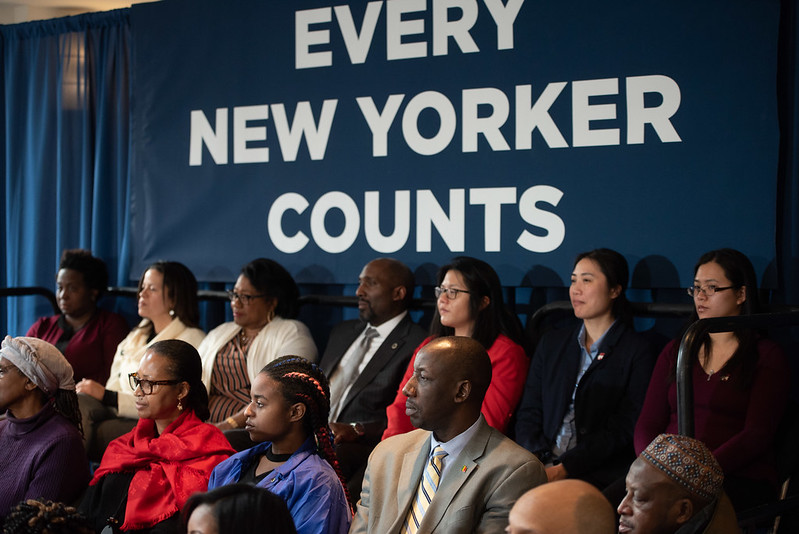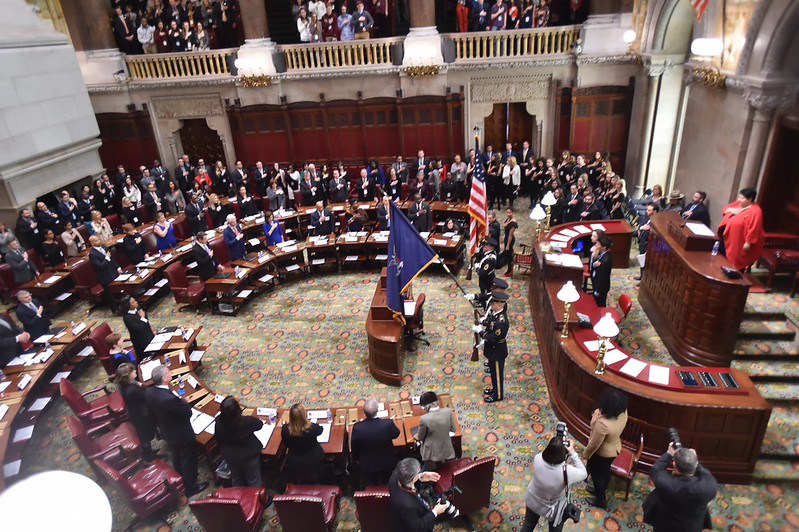Coronavirus Ravaged New York's Budget and Made Your Census Participation More Important Than Ever

New York City Census efforts (photo: Michael Appleton/Mayoral Photography Office)
As the cost to confront COVID-19 grows each day, a severe fiscal fallout for New York’s state and city budgets becomes more of a certainty. And with steep cuts to government programs all but assured, we New Yorkers cannot overlook the significance of participating in this year’s Census. Consider this: New York’s recovery will depend on federal funding, and each person not counted can cost New York $3,054 critical to providing education, housing, transportation, and medical services in areas hit hard by COVID-19.
If New York City has the same low response rate that it did in 2010, it is likely that nearly 2.5 million people in New York City will not be counted in the self-response phase. This would equate to nearly $8 billion in lost federal funding, which happens to be about the projected shortfall in the city budget for this and next fiscal years. Representation in Congress is on the line, too. Because of a low count last Census, New York lost two seats in the House of Representatives.
With federal funding and equitable political representation critical to our recovery, the stakes of the Census couldn’t be higher. It is imperative that New Yorkers, especially those from historically undercounted immigrant and underserved communities, respond to the decennial count in droves. At the same time, the pandemic will make it even harder for some in these communities to participate.
As CEO of RiseBoro Community Partnership, a nonprofit that offers holistic services to meet community needs in Brooklyn, I know how structural racism and poverty often lead to marginalization. Brooklyn is notoriously the hardest-to-count county in all of New York. In the 2010 Census, Brooklyn had the lowest mail return rate in the country among counties with populations over 500,000. Approximately 80% of Brooklynites live in hard-to-count neighborhoods. 2020 is the year to buck that trend and ensure that low-income communities and people of color get fully counted.
States with the greatest number of people and highest concentrations of poverty receive proportionally greater amounts of federal aid than other states. Over 14% of the 19.5 million people living in New York State are below the poverty line. If underserved groups are not accurately represented in the Census, organizations like RiseBoro have a difficult time meeting the needs that exist in the communities they serve because of a lack of funding.
My organization is working in partnership with the City University of New York (CUNY), the mayor’s Census office, and the New York City Council to mobilize New Yorkers to self-respond to the 2020 Census. We received $250,000 to support a fair and complete count of Bushwick, Brownsville, and Crown Heights—three communities with poverty levels up to 40%.
The barriers to responding to the Census that these underserved communities faced in 2010 still exist today. There is limited English literacy; there are motives for concealment, such as undocumented status; and children under five and seniors are often undercounted. Brooklyn has the largest population of seniors and children under five in New York City.
Like most of the five boroughs, Brooklyn is a melting pot of cultures, and that is particularly true in Bushwick, Brownsville, and Crown Heights. In these communities the most common languages other than English are Spanish, Mandarin, and Cantonese. Residents typically rely on places like libraries and community centers to fill out the Census. With COVID-19 making that impossible, it’s up to community organizations to take the lead.
At RiseBoro, staff fluent in these languages are making calls to help people fill out their forms. With many in these communities concerned about their immigration status, being able to speak with someone in their own language is a way to put them at ease.
About 400,000 Brooklynites—15% of our borough’s total population—are not U.S. citizens. To every immigrant and person from an underserved community reading this, know that you are in no way in jeopardy of being deported because of your Census answers. Despite previous efforts by the Trump Administration, the 2020 Census contains no question about citizenship status.
Your response is vital to providing resources to you, your family, and your community. The Census results will inform how federal funding is allocated to programs you and other New Yorkers depend on, including Medicaid, community mental health services, and the Supplemental Nutrition Assistance Program (SNAP).
As a city, we need to put extra effort into responding to the Census. We are fighting for our share of over $650 billion a year that the federal government allocates, and with the coronavirus decimating New York’s budget, every person counts.
***
Scott Short is the CEO of RiseBoro Community Partnership, a nonprofit dedicated to holistic community revitalization in New York City. On Twitter @RiseboroNYC.
***
Have an op-ed idea or submission for Gotham Gazette? Email This email address is being protected from spambots. You need JavaScript enabled to view it.
Ensuring Domestic Violence Survivors Have the Resources They Need

Purple lights for domestic violence awareness (photo: Kevin P. Coughlin/Governor's Office)
Over the past three months, our lives have come to depend almost entirely on technology. Canceled your wedding? Get married on Zoom! Want to introduce a new baby to the family? FaceTime them. Technology has allowed us to stay virtually connected when we are more physically disconnected than ever due to COVID-19.
But for domestic violence survivors, technology can be a double-edged sword. It can connect them to help, but it can also become a dangerous tool in the hands of their abuser.
As with everything else, the New York City Family Courts have gone almost entirely virtual. Emergency filings, like for an Order of Protection, are now done by email and cases are heard over the phone. But instructions on where and how to file change frequently, are not publicly available, and are confusing even for attorneys like myself. If you can figure out how to file, emergency petitions require consistent telephone and often internet access: Survivors spend potentially hours on the computer writing their petition, on the phone with an attorney, waiting for the court to call their case, and being heard by the judge.
Accessing those resources—time, space, internet, phone—is exceedingly complex for survivors who are still living with their abusers. Understanding this dilemma, the New York State Office for the Prevention of Domestic Violence unveiled a new chat service, which allows survivors to text 24/7 with domestic violence specialists. This might help connect people with other services and inform them about their rights, but it still assumes access to reliable internet or phone service and that the survivor’s phone is not being monitored by their abuser.
The circumstances can be even worse for survivors with limited means, and according to the National Network to End Domestic Violence, economic abuse occurs in 99% of domestic violence cases. The number of people experiencing poverty is also likely to grow as we face what the International Monetary Fund is predicting will be the worst economic downturn since the Great Depression.
Indeed, despite indications that domestic violence is on the rise, many organizations, including the New York Legal Assistance Group (NYLAG), where I am a Staff Attorney, have experienced a paradoxical decrease in hotline calls and cases. In Queens, the New York Times reported that domestic violence arrests have fallen nearly 40 percent. Why? While data is scarce, our experience suggests that this is because the few resources that are still available for abuse survivors are difficult if not impossible for those living with their abusers and/or in poverty to access.
Instead of accepting this as the status quo, we need to build a system that actually works for survivors—both for the duration of this crisis and for the next one.
I suggest a two-pronged approach. First, to truly keep survivors safe, everyone needs access to free basic internet, free basic cell phone services, and free mental health services. These are lifelines. The tragic truth is that domestic violence too often leads to death. Survivors need to be able to call not only 911 and 311, but the courts, the Family Justice Centers, and legal service providers like NYLAG. They need to be able to make these phone calls even when their abuser cuts them off financially. Even when they are experiencing poverty and can’t pay their phone or internet bill.
Research indicates that financial abuse occurs in 99% of domestic violence cases. Abusers often cut off their partner’s access to essential resources--like money, phone, and internet--in moments when they feel their partner is most likely to seek help. If everyone has access to free phone and internet, no one is dependent on an abusive partner to contact the courts, attorneys, or social workers.
But providing these basic services does not solve the entire problem because it still excludes those who are living with their abusers and those whose abusers are monitoring their devices. We also need to engage with people in the spaces we all still inhabit.
Most of us still go to grocery stores, bodegas, pharmacies, hardware stores, banks, and hospitals. Signs in the predominant languages of each neighborhood could be posted with instructions on how to access these resources. Staff in these places could be trained to provide information to those who need it. Police precincts could provide safe, clean spaces for survivors to take phone calls with their attorneys or the courts.
Now is the time to enact these changes to ensure that every resident of our city has a basic safety net under both ordinary and extraordinary circumstances.
***
Micah Horwitz, Esq. is a staff attorney in the New York Legal Assistance Group’s Domestic Violence Law Unit.
***
Have an op-ed idea or submission for Gotham Gazette? Email This email address is being protected from spambots. You need JavaScript enabled to view it.
Democratic Voters are Electing Presidential Delegates; Here’s How It Works and What It Means

Electors voting in Albany in 2016 (photo: Kevin P. Coughlin/Governor's Office)
The Presidential Primary is complicated. As New York State’s failed attempt to cancel it shows, there’s more at stake than just the Democratic nominee. Instead, hundreds of delegates are running around the country in their own right to give their communities a seat at the table.
So, what do delegates do? And why, in New York, can you vote for presidential candidates and delegates separately?
Selecting the Party nominee for President
When you vote for the Democratic nominee in the Presidential Primary, you are not actually voting for a candidate. You are voting for what proportion of delegates they should get from your district.
In New York, your Delegate District is your Congressional District (CD). Every district gets a certain number of delegates based on a formula (that I won’t go into now). When you vote for a presidential candidate, you are voting for what percentage of the delegates they get. If they get 35% percent of the vote in the district, they get 35% of the delegates. Those delegates go to the national convention.
Since, in theory, a candidate could win 100% of the vote, most run more delegates -- a slate -- than will be able to attend the convention.
That’s where voting for delegates comes in...
Regardless of your presidential candidate vote, you can separately vote for any delegate you want — even if they support a different candidate. Regardless of how many votes a presidential candidate gets, the order of delegates who will get to attend the national convention with them is based on how many votes the individual delegates receive.
So, if your Congressional District gets 100 delegates to the national convention, and Candidate A gets 50% of the primary vote, that candidate gets 50 delegates from your district to the convention. But how does the candidate choose which 50 from their slate have the honor? Whichever delegates get the most votes.
As a result, if you support Joe Biden, but your friend supports Bernie Sanders and is running to be a delegate to the convention, you can vote for Biden, to give him more New York delegates, but you can also vote for your friend, to make her more likely to BE a delegate among Sanders’ number.
There is one caveat, though. The delegate rolls alternate female-male. So the delegate list is the highest vote-getters, but it flips between the highest female vote-getter and the highest male-vote getter for each slot.
Delegates do More than Select the Nominee
If all delegates did was select the presidential nominee, cancelling the primary wouldn’t matter after everyone had dropped out and conceded to Biden. But that’s not the case.
Delegates are the actual representatives of registered party members to the national organization. They are responsible for ratifying or changing the Party Rules and the Party Platform. If you want to push an issue to the Party Platform, or change the Party Rules, you need a delegate who’s on board.
I wrote more explaining just how important the delegates are to the political process here, but suffice it to say, their independent role in Democratic Party and political governance is why New York State was court-ordered to proceed with the Presidential Primary.
In the end, these delegates are not merely presidential delegates, they are Democratic National Convention delegates — one of Democratic voters’ many representatives to your political party.
Remember, only registered Democrats can vote in the various Democratic primaries this month and for Presidential Delegates. To see who is running for Presidential Delegate in your Congressional District, enter your address here and follow the steps to find your sample ballot for the presidential primary (there are two spots for sample ballots on the page, as well as poll-site info for early voting and primary day).
***
Ben Yee is the Democratic State Committeeman for New York's 66th Assembly District and former Secretary of the Manhattan Democratic Party. On Twitter at @yben.
***
Have an op-ed idea or submission for Gotham Gazette? Email This email address is being protected from spambots. You need JavaScript enabled to view it.




